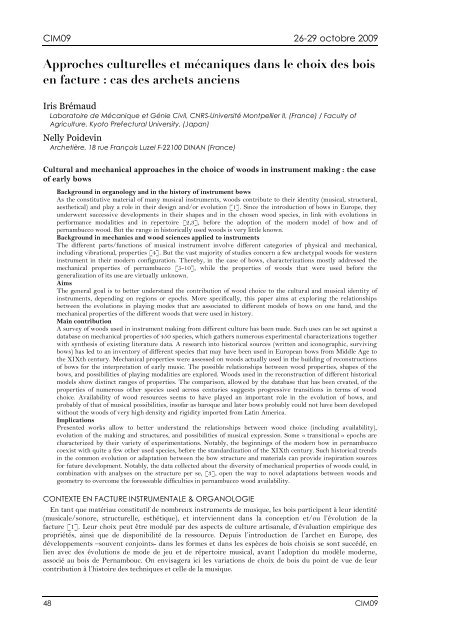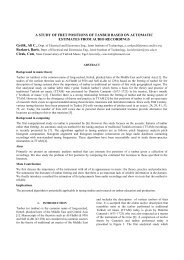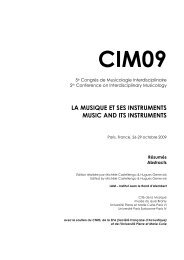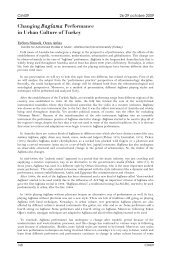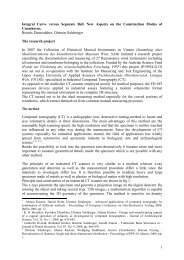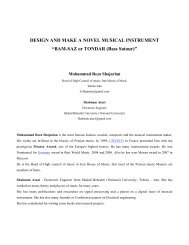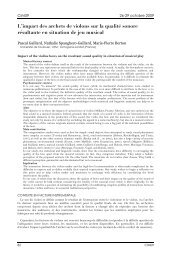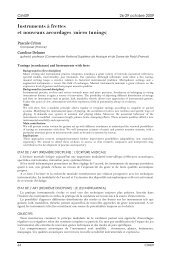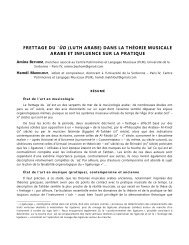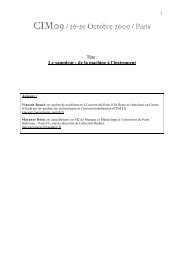Approches culturelles et mécaniques dans le choix des bois en ...
Approches culturelles et mécaniques dans le choix des bois en ...
Approches culturelles et mécaniques dans le choix des bois en ...
- No tags were found...
You also want an ePaper? Increase the reach of your titles
YUMPU automatically turns print PDFs into web optimized ePapers that Google loves.
CIM09 26-29 octobre 2009<br />
<strong>Approches</strong> <strong>culturel<strong>le</strong>s</strong> <strong>et</strong> mécaniques <strong>dans</strong> <strong>le</strong> <strong>choix</strong> <strong>des</strong> <strong>bois</strong><br />
<strong>en</strong> facture : cas <strong>des</strong> arch<strong>et</strong>s anci<strong>en</strong>s<br />
Iris Brémaud<br />
Laboratoire de Mécanique <strong>et</strong> Génie Civil, CNRS-Université Montpellier II, (France) / Faculty of<br />
Agriculture, Kyoto Prefectural University, (Japan)<br />
Nelly Poidevin<br />
Arch<strong>et</strong>ière, 18 rue François Luzel F-22100 DINAN (France)<br />
Cultural and mechanical approaches in the choice of woods in instrum<strong>en</strong>t making : the case<br />
of early bows<br />
Background in organology and in the history of instrum<strong>en</strong>t bows<br />
As the constitutive material of many musical instrum<strong>en</strong>ts, woods contribute to their id<strong>en</strong>tity (musical, structural,<br />
aesth<strong>et</strong>ical) and play a ro<strong>le</strong> in their <strong>des</strong>ign and/or evolution [1]. Since the introduction of bows in Europe, they<br />
underw<strong>en</strong>t successive developm<strong>en</strong>ts in their shapes and in the chos<strong>en</strong> wood species, in link with evolutions in<br />
performance modalities and in repertoire [2,3], before the adoption of the modern model of bow and of<br />
pernambucco wood. But the range in historically used woods is very litt<strong>le</strong> known.<br />
Background in mechanics and wood sci<strong>en</strong>ces applied to instrum<strong>en</strong>ts<br />
The differ<strong>en</strong>t parts/functions of musical instrum<strong>en</strong>t involve differ<strong>en</strong>t categories of physical and mechanical,<br />
including vibrational, properties [4]. But the vast majority of studies concern a few arch<strong>et</strong>ypal woods for western<br />
instrum<strong>en</strong>t in their modern configuration. Thereby, in the case of bows, characterizations mostly addressed the<br />
mechanical properties of pernambucco [5-10], whi<strong>le</strong> the properties of woods that were used before the<br />
g<strong>en</strong>eralization of its use are virtually unknown.<br />
Aims<br />
The g<strong>en</strong>eral goal is to b<strong>et</strong>ter understand the contribution of wood choice to the cultural and musical id<strong>en</strong>tity of<br />
instrum<strong>en</strong>ts, dep<strong>en</strong>ding on regions or epochs. More specifically, this paper aims at exploring the relationships<br />
b<strong>et</strong>we<strong>en</strong> the evolutions in playing mo<strong>des</strong> that are associated to differ<strong>en</strong>t models of bows on one hand, and the<br />
mechanical properties of the differ<strong>en</strong>t woods that were used in history.<br />
Main contribution<br />
A survey of woods used in instrum<strong>en</strong>t making from differ<strong>en</strong>t culture has be<strong>en</strong> made. Such uses can be s<strong>et</strong> against a<br />
database on mechanical properties of 450 species, which gathers numerous experim<strong>en</strong>tal characterizations tog<strong>et</strong>her<br />
with synthesis of existing literature data. A research into historical sources (writt<strong>en</strong> and iconographic, surviving<br />
bows) has <strong>le</strong>d to an inv<strong>en</strong>tory of differ<strong>en</strong>t species that may have be<strong>en</strong> used in European bows from Midd<strong>le</strong> Age to<br />
the XIXth c<strong>en</strong>tury. Mechanical properties were assessed on woods actually used in the building of reconstructions<br />
of bows for the interpr<strong>et</strong>ation of early music. The possib<strong>le</strong> relationships b<strong>et</strong>we<strong>en</strong> wood properties, shapes of the<br />
bows, and possibilities of playing modalities are explored. Woods used in the reconstruction of differ<strong>en</strong>t historical<br />
models show distinct ranges of properties. The comparison, allowed by the database that has be<strong>en</strong> created, of the<br />
properties of numerous other species used across c<strong>en</strong>turies suggests progressive transitions in terms of wood<br />
choice. Availability of wood resources seems to have played an important ro<strong>le</strong> in the evolution of bows, and<br />
probably of that of musical possibilities, insofar as baroque and later bows probably could not have be<strong>en</strong> developed<br />
without the woods of very high d<strong>en</strong>sity and rigidity imported from Latin America.<br />
Implications<br />
Pres<strong>en</strong>ted works allow to b<strong>et</strong>ter understand the relationships b<strong>et</strong>we<strong>en</strong> wood choice (including availability),<br />
evolution of the making and structures, and possibilities of musical expression. Some « transitional » epochs are<br />
characterized by their vari<strong>et</strong>y of experim<strong>en</strong>tations. Notably, the beginnings of the modern bow in pernambucco<br />
coexist with quite a few other used species, before the standardization of the XIXth c<strong>en</strong>tury. Such historical tr<strong>en</strong>ds<br />
in the common evolution or adaptation b<strong>et</strong>we<strong>en</strong> the bow structure and materials can provide inspiration sources<br />
for future developm<strong>en</strong>t. Notably, the data col<strong>le</strong>cted about the diversity of mechanical properties of woods could, in<br />
combination with analyses on the structure per se, [3], op<strong>en</strong> the way to novel adaptations b<strong>et</strong>we<strong>en</strong> woods and<br />
geom<strong>et</strong>ry to overcome the foreseeab<strong>le</strong> difficulties in pernambucco wood availability.<br />
CONTEXTE EN FACTURE INSTRUMENTALE & ORGANOLOGIE<br />
En tant que matériau constitutif de nombreux instrum<strong>en</strong>ts de musique, <strong>le</strong>s <strong>bois</strong> particip<strong>en</strong>t à <strong>le</strong>ur id<strong>en</strong>tité<br />
(musica<strong>le</strong>/sonore, structurel<strong>le</strong>, esthétique), <strong>et</strong> intervi<strong>en</strong>n<strong>en</strong>t <strong>dans</strong> la conception <strong>et</strong>/ou l’évolution de la<br />
facture [1]. Leur <strong>choix</strong> peut être modulé par <strong>des</strong> aspects de culture artisana<strong>le</strong>, d’évaluation empirique <strong>des</strong><br />
propriétés, ainsi que de disponibilité de la ressource. Depuis l’introduction de l’arch<strong>et</strong> <strong>en</strong> Europe, <strong>des</strong><br />
développem<strong>en</strong>ts –souv<strong>en</strong>t conjoints- <strong>dans</strong> <strong>le</strong>s formes <strong>et</strong> <strong>dans</strong> <strong>le</strong>s espèces de <strong>bois</strong> choisis se sont succédé, <strong>en</strong><br />
li<strong>en</strong> avec <strong>des</strong> évolutions de mode de jeu <strong>et</strong> de répertoire musical, avant l’adoption du modè<strong>le</strong> moderne,<br />
associé au <strong>bois</strong> de Pernambouc. On <strong>en</strong>visagera ici <strong>le</strong>s variations de <strong>choix</strong> de <strong>bois</strong> du point de vue de <strong>le</strong>ur<br />
contribution à l’histoire <strong>des</strong> techniques <strong>et</strong> cel<strong>le</strong> de la musique.<br />
48 CIM09
26-29 octobre 2009 CIM09<br />
CONTEXTE EN MÉCANIQUE ET SCIENCES DU BOIS<br />
Plusieurs étu<strong>des</strong> se sont p<strong>en</strong>chées sur <strong>le</strong>s propriétés mécaniques <strong>et</strong> vibratoires <strong>des</strong> <strong>bois</strong> d’instrum<strong>en</strong>ts de<br />
musique [2], mais el<strong>le</strong>s port<strong>en</strong>t presque toujours sur un nombre restreint d’ess<strong>en</strong>ces « archétypes » pour<br />
<strong>des</strong> instrum<strong>en</strong>ts occid<strong>en</strong>taux <strong>dans</strong> <strong>le</strong>ur configuration moderne. Ainsi, pour <strong>le</strong>s arch<strong>et</strong>s, <strong>le</strong>s caractérisations<br />
concern<strong>en</strong>t surtout <strong>le</strong> Pernambouc [3,4], mais <strong>le</strong>s propriétés mécaniques <strong>des</strong> <strong>bois</strong> employés avant la<br />
généralisation de son usage sont quasim<strong>en</strong>t inconnues. On cherchera <strong>dans</strong> ce travail à relier <strong>des</strong> aspects de<br />
mécanique <strong>des</strong> matériaux <strong>et</strong> d’<strong>et</strong>hnobotanique.<br />
OBJECTIF<br />
Notre travail a pour objectif général de mieux appréh<strong>en</strong>der la contribution <strong>des</strong> <strong>choix</strong> de <strong>bois</strong> <strong>dans</strong><br />
l’id<strong>en</strong>tité culturel<strong>le</strong> <strong>et</strong> musica<strong>le</strong> <strong>des</strong> instrum<strong>en</strong>ts, <strong>et</strong> <strong>le</strong>ur perman<strong>en</strong>ce ou diverg<strong>en</strong>ce selon <strong>le</strong>s régions ou<br />
époques. C<strong>et</strong>te prés<strong>en</strong>tation vise plus spécifiquem<strong>en</strong>t à repérer <strong>et</strong> caractériser <strong>le</strong>s ess<strong>en</strong>ces employées au<br />
cours de l’histoire <strong>dans</strong> <strong>le</strong>s arch<strong>et</strong>s Europé<strong>en</strong>s, <strong>en</strong> regard de changem<strong>en</strong>ts <strong>dans</strong> <strong>le</strong>s contextes musicaux, de<br />
facture, <strong>et</strong> de ressource.<br />
CONTRIBUTION PRINCIPALE<br />
A partir de campagnes expérim<strong>en</strong>ta<strong>le</strong>s ext<strong>en</strong>sives portant sur <strong>des</strong> <strong>bois</strong> utilisés ou utilisab<strong>le</strong>s <strong>en</strong> facture<br />
instrum<strong>en</strong>ta<strong>le</strong>, complétées par une analyse de nombreuses sources de la littérature, une base de données<br />
relationnel<strong>le</strong> dédiée aux <strong>bois</strong> employés <strong>en</strong> facture d’instrum<strong>en</strong>ts de différ<strong>en</strong>tes aires géo<strong>culturel<strong>le</strong>s</strong> a été<br />
créée [5]. El<strong>le</strong> perm<strong>et</strong> de relier de façon dynamique <strong>le</strong>s informations sur <strong>le</strong>s usages <strong>en</strong> facture, <strong>le</strong>s espèces<br />
botaniques, <strong>et</strong> <strong>le</strong>s propriétés vibratoires <strong>des</strong> <strong>bois</strong>. C<strong>et</strong> outil ouvre la voie à <strong>des</strong> analyses comparatives <strong>des</strong><br />
matériaux choisis, selon <strong>le</strong>s cultures musica<strong>le</strong>s <strong>et</strong> matériel<strong>le</strong>s. Le travail spécifique aux <strong>bois</strong> employés <strong>dans</strong><br />
l’histoire pour <strong>le</strong>s arch<strong>et</strong>s europé<strong>en</strong>s s’appuie sur 3 démarches complém<strong>en</strong>taires : (i) recherche<br />
d’informations historiques (disponibilité de la ressource, arch<strong>et</strong>s conservés, analyse de sources écrites <strong>et</strong>/ou<br />
iconographiques) ; (ii) tests <strong>dans</strong> la reconstitution de modè<strong>le</strong>s anci<strong>en</strong>s ; (iii) caractérisation expérim<strong>en</strong>ta<strong>le</strong><br />
<strong>des</strong> propriétés mécaniques <strong>des</strong> <strong>bois</strong> repérés, à partir d’échantillons jumeaux <strong>des</strong> arch<strong>et</strong>s réalisés. Les<br />
résultats montr<strong>en</strong>t <strong>des</strong> associations modè<strong>le</strong>-matériau assez clairem<strong>en</strong>t définies, <strong>et</strong> indiqu<strong>en</strong>t une adaptation<br />
de la conception à un contexte (musical <strong>et</strong> de ressource). Ainsi, <strong>le</strong> développem<strong>en</strong>t <strong>des</strong> arch<strong>et</strong>s baroques a<br />
vraisemblab<strong>le</strong>m<strong>en</strong>t été r<strong>en</strong>du possib<strong>le</strong> par l’importation de <strong>bois</strong> Sud-Américains de d<strong>en</strong>sité <strong>et</strong> rigidité<br />
extrêmes, tandis que <strong>le</strong>s modè<strong>le</strong>s antérieurs sont adaptés aux propriétés de <strong>bois</strong> europé<strong>en</strong>s. Par ail<strong>le</strong>urs,<br />
avant l’adoption du Pernambouc comme <strong>bois</strong> quasi exclusif <strong>des</strong> arch<strong>et</strong>s modernes, <strong>le</strong>s <strong>choix</strong> ont couvert une<br />
certaine diversité d’espèces <strong>et</strong> d’expérim<strong>en</strong>tations, mais au sein de laquel<strong>le</strong> on peut r<strong>et</strong>rouver <strong>des</strong> <strong>en</strong>semb<strong>le</strong>s<br />
cohér<strong>en</strong>ts <strong>en</strong> termes de propriétés <strong>des</strong> <strong>bois</strong>.<br />
IMPLICATIONS<br />
Les résultats obt<strong>en</strong>us perm<strong>et</strong>t<strong>en</strong>t d’éclairer <strong>le</strong>s relations <strong>en</strong>tre disponibilité d’une ressource, culture<br />
matériel<strong>le</strong> <strong>et</strong> culture musica<strong>le</strong>. Les artisans ont ainsi sé<strong>le</strong>ctionné, parmi une large biodiversité, <strong>des</strong> <strong>bois</strong><br />
adaptés à <strong>des</strong> cultures différ<strong>en</strong>tes, tandis que l’apparition de <strong>bois</strong> « nouveaux » a pu susciter <strong>des</strong> innovations.<br />
Ils illustr<strong>en</strong>t éga<strong>le</strong>m<strong>en</strong>t que la sé<strong>le</strong>ction de matériau <strong>en</strong> facture suppose une adaptation à un contexte, plutôt<br />
qu’une seu<strong>le</strong> maximisation de paramètres mécaniques. En parallè<strong>le</strong>, <strong>le</strong>s travaux <strong>en</strong>gagés peuv<strong>en</strong>t s’inscrire<br />
<strong>dans</strong> <strong>des</strong> problématiques actuel<strong>le</strong>s, <strong>en</strong> perm<strong>et</strong>tant par exemp<strong>le</strong> de proposer <strong>des</strong> pistes de <strong>bois</strong> alternatifs au<br />
Pernambouc, inscrit depuis 2007 à la CITES. On peut ainsi <strong>en</strong>visager que <strong>le</strong>s co-évolutions forme-matériau<br />
observées au cours de l’histoire puisse trouver une prolongation <strong>dans</strong> l’adaptation à de nouveaux <strong>bois</strong>.<br />
REFERENCES<br />
[1] Brémaud, I. and N. Poidevin (2004). "Wood se<strong>le</strong>ction and processing in the evolution of musical instrum<strong>en</strong>t's<br />
<strong>des</strong>ign and realization". IASS 2004 - IASS Symposium Shell and Spatial Structures from Models to Realization,<br />
September 2004, Montpellier, France.<br />
[2] Bucur, V. (2006). "Acoustics of wood". Berlin Heidelberg NewYork, Springer-Verlag.393 p.<br />
[3] Matsunaga, M., M. Sugiyama, K. Minato and M. Norimoto (1996). "Physical and mechanical properties<br />
required for violin bow materials." Holzforschung 50:pp 511-517.<br />
[4] Wegst, U. G. K., S. Oberhoff, M. Wel<strong>le</strong>r and M. F. Ashby (2007). "Materials for violin bows." International Journal<br />
of Materials Research 98(12):pp 1230-1237.<br />
[5] Brémaud, I., B. Thibaut and K. Minato (2007). "A database linking woody species, vibrational properties, and<br />
uses in musical instrum<strong>en</strong>ts of the world". ISMA (International Symposium on Musical Acoustics) 2007, 9-12<br />
September 2007. Barcelona, Spain.<br />
CIM09 49
CIM09 26-29 octobre 2009<br />
BIOGRAPHIES<br />
Iris Brémaud<br />
Post-Doctorat au Laboratory of Forest Products Circulating Circ<strong>le</strong>s, Kyoto Prefectural University, Japan<br />
Doctorat <strong>en</strong> Mécanique au Laboratoire de Mécanique & Génie Civil, U. Montpellier II, & CIRAD : « Diversité <strong>des</strong><br />
<strong>bois</strong> utilisés ou utilisab<strong>le</strong>s <strong>en</strong> facture instrum<strong>en</strong>ta<strong>le</strong> »<br />
DEA <strong>en</strong> Sci<strong>en</strong>ces du <strong>bois</strong>, Nancy, après maîtrise <strong>en</strong> biologie végéta<strong>le</strong>, Montpellier.<br />
Appr<strong>en</strong>tissage de la facture de guitares <strong>et</strong> luths.<br />
Contact : iris_bremaud@hotmail.com<br />
Nelly Poidevin<br />
Arch<strong>et</strong>ière, spécialisée <strong>dans</strong> la reconstitution d’arch<strong>et</strong>s anci<strong>en</strong>s, du Moy<strong>en</strong> Age à l’époque classique<br />
Prix de la Facture Instrum<strong>en</strong>ta<strong>le</strong>, Musicora 2008<br />
Membre de l’Union Nationa<strong>le</strong> de la Facture Instrum<strong>en</strong>ta<strong>le</strong> (UNFI)<br />
Contact : http://www.arch<strong>et</strong>s-poidevin.com<br />
nelly.poidevin@wanadoo.fr<br />
50 CIM09


